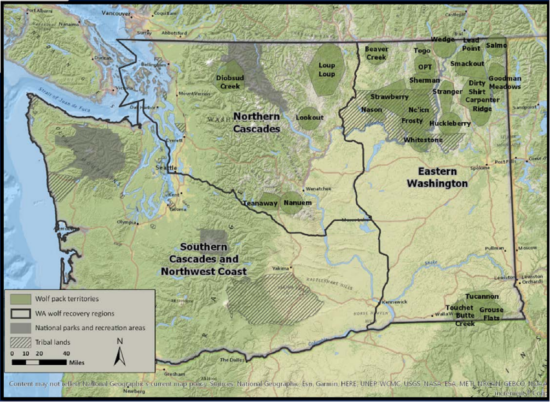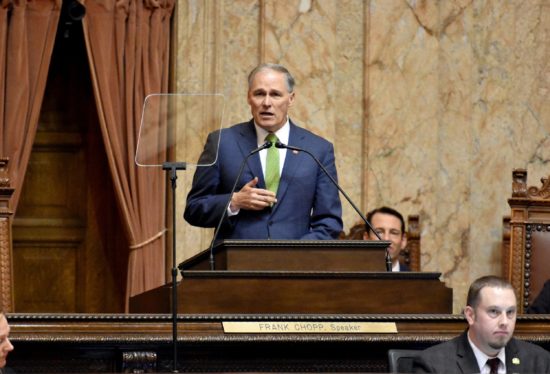WDFW Responds To Inslee’s Kettle Range Wolf Management Request
Washington wildlife managers are responding to Governor Jay Inslee’s request to do something different in a very problematic part of the state for wolves and cattle, terming it a “top priority.”
“The forest conditions and livestock operations in this particular landscape make it extremely challenging, and unfortunately, has resulted in repeated lethal removal actions. We all share the perspective that something has to change to reduce the loss of both wolves and livestock in this area. WDFW believes this is consistent with the Governor’s request,” a statement sent out this afternoon to Northwest Sportsman reads.

It follows on Inslee’s letter to Director Kelly Susewind last night asking the state agency to “make changes in the gray wolf recovery program to further increase the reliance on non-lethal methods, and to significantly reduce the need for lethal removal of this species.”
Wolves roaming northern Ferry County’s Kettle Range were taken out by WDFW in 2016, 2018 and again this summer in response to chronic depredations on cattle mostly owned by a single ranch, the Diamond M, and largely grazing on federal forest allotments.
The straw that broke the proverbial camel’s back may have been piled on in mid-July, about a month before WDFW killed the last four of the eight members of the Old Profanity Territory Pack right before a court date.
The state operates under an agreed-to protocol where producers need to have been using a set number of livestock-wolf conflict avoidance measures and suffer either three wolf attacks in 30 days or four in 10 months before lethal removal is considered.

Even as WDFW’s gray wolf email blasts chronicled preventative steps as well as the evidence the OPTs were responsible for nearly 30 attacks stretching back to last year, a mid-July update also states, “WDFW-contracted range riders did not resume riding because the livestock producer prefers that contracted range riders not work with the producer’s cattle at this time.”
Range riders are not mentioned in subsequent updates.
Just as some cowboys are all hat, certainly not all range riders are created equal, and it’s an operator’s prerogative whether to use those offered.
But pressure has also been growing on the Democratic governor running for a third term from outside as well as inside the state to do something different in this thick, steep, half-burnt neck of the woods.
Some will see Inslee’s move as inserting himself and outside opinions about wildlife into state management, as well as meddling in affairs outside his depth.
“Perhaps Gov. Inslee, whose ideas about climate change propelled his presidential campaign into a political black hole, will have more luck dazzling voters with his wolf management expertise,” shot longtime Washington hunter and gun writer Dave Workman.
Scott Nielsen of the Cattle Producers of Washington said he’d like to see Inslee more worried about his herd, per a Capital Press story out today.
Indeed, it will be very interesting to see what better ideas the governor and his staff can come up with for better managing this cauldron.

Some appear to want an all-but-hands-off wolf management approach, with the Center For Biological Diversity trumpeting about Inslee’s request for a new tack and his appreciation for “these ecologically essential and wondrous animals.”
It will also be interesting to see if CBD gets involved more closely going forward.
Instate wolf advocates say they are glad Inslee weighed in.
Conservation Northwest put out a statement this morning stating they agree “that more work is needed in certain areas, including northeast Washington’s Kettle River Mountain Range. We’re committed to collaborating with agency staff, ranchers, biologists and others to continue moving towards the goal of long-term recovery and public acceptance of wolves alongside thriving local communities.”
Love them, loath them or just wish this never-ending cow-lupus drama would end already, ultimately in a state like Washington, wolves are going to be around for a very long time, and there are other aspects of their management that have gone overlooked for far too long and deserve time too, namely ungulate impacts and possible hunting permits down the road.
Whether this new push from the governor helps or hurts that remains to be seen as well.
As it stands, roughly 90 percent of the state’s 27 known packs aren’t causing any issues with livestock — this grazing season anyway — according to WDFW.
But with conflict in the Kettles “greatly impacting many of our communities, including ranching communities, environmental communities,” and itself, WDFW said it will “continue working with the Wolf Advisory Group and stakeholders on minimizing conflict proactively with lethal removal as a last resort.”
“We are also engaging with the local community, the US Forest Service, and others to seek new solutions for this challenging landscape,” WDFW stated.
Meanwhile, there are two ongoing wolf removal authorizations in Eastern Washington that have not been placed on hold because of the governor’s letter.
“The Togo authorization still stands, although we haven’t been actively working to remove wolves from that pack in several weeks as the right opportunity — conducive weather, employee schedules, helicopter scheduling, etc. — hasn’t been available,” said a spokeswoman.
The Togo operation began not long after the nearby OPT removals, but in sharp contrast, no pack members have been killed.
“The Grouse Flats authorization still stands as well,” the spokeswoman added.
It’s the first against a pack in all of Southeast Washington since wolves began moving back into the neighborhood.
